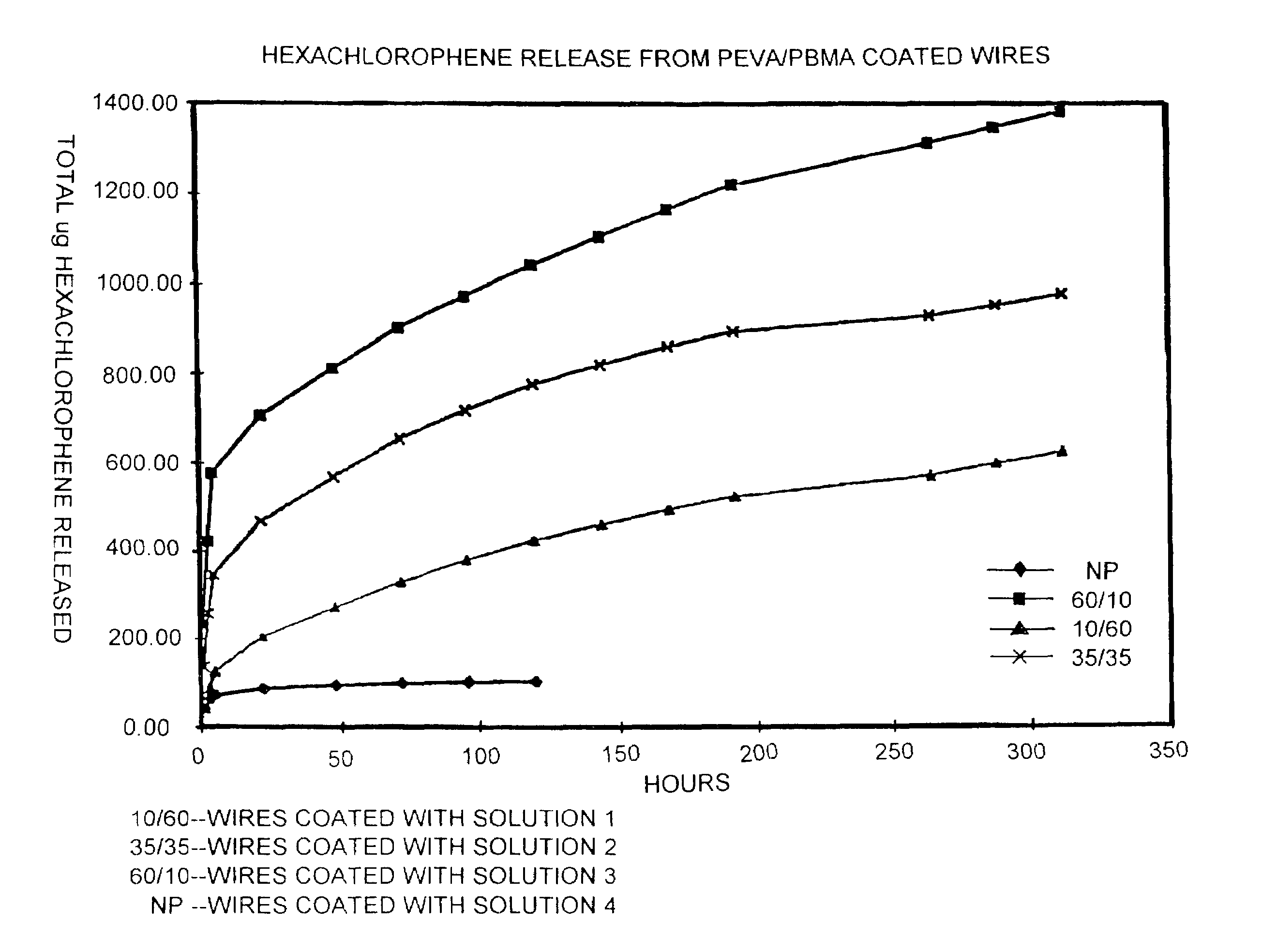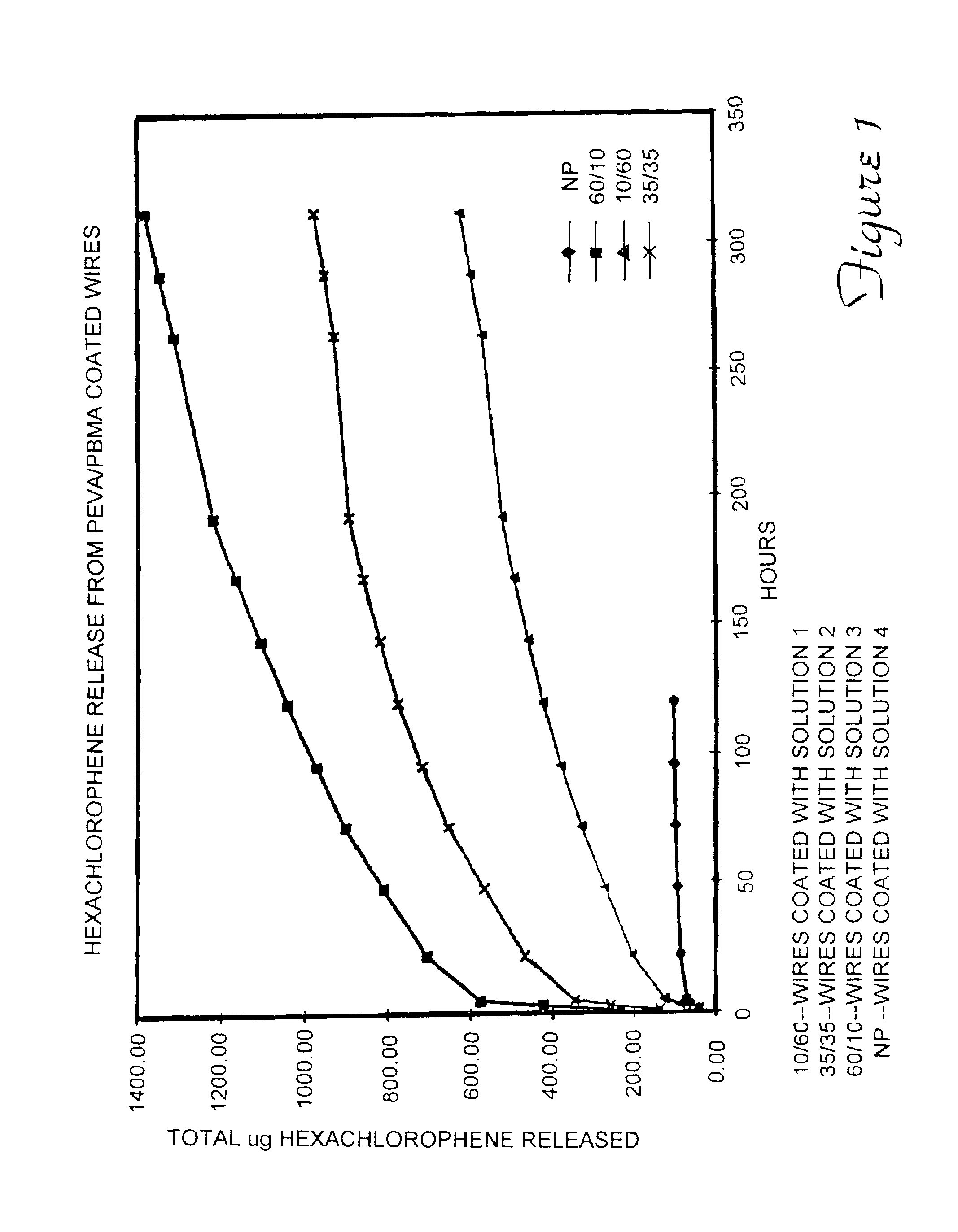Bioactive agent release coating
a bioactive agent and coating technology, applied in the direction of prosthesis, catheters, food packaging, etc., can solve the problems of increasing the risk of infection, and affecting the quality of life of the implanted medical device, so as to simplify the manufacture of bioactive-releasing implantable medical devices
- Summary
- Abstract
- Description
- Claims
- Application Information
AI Technical Summary
Benefits of technology
Problems solved by technology
Method used
Image
Examples
example 1
[0045]Release of Hexachlorophene from Coated Stainless Steel Wires A one millimeter diameter stainless steel wire (304 grade) was cut into two centimeter segments. The segments were treated with Parylene C coating composition (Parylene is a trademark of the Union Carbide Corporation). This treatment deposits a thin, conformal, polymeric coating on the wires.
[0046]Four solutions were prepared for use in coating the wires. The solutions included mixtures of: pEVA (33 weight percent vinyl acetate, from Aldrich Chemical Company, Inc.); poly(butyl methacrylate “pBMA”) (337,000 average molecular weight, from Aldrich Chemical Company, Inc.); and hexachlorophene (“HCP”) from Sigma Chemical Co., dissolved in tetrahydrofuran. The solutions were prepared as follows:[0047]1) 10 mg / ml pEVA / / 60 mg / ml pBMA / / 100 mg / ml HCP[0048]2) 35 mg / ml pEVA / / 35 mg / ml pBMA / / 100 mg / ml HCP[0049]3) 60 mg / ml pEVA / / 10 mg / ml pBMA / / 100 mg / ml HCP[0050]4) 0 mg / ml pEVA / / 0 mg / ml pBMA / / 100 mg / ml HCP
[0051]Nine wire segments w...
example 2
[0054]The polymers described in this disclosure have been evaluated using an Assay protocol as outlined above. The polymer mixtures evaluated have ranged from 100% pBMA to 100% pEVA. Representative results of those evaluations are summarized below.
[0055]Control coatings that are made up entirely of pBMA are very durable showing no signs of wear in the Durability Test. When subjected to the Flexibility Test, however, these coatings develop cracks, particularly in the presence of significant concentrations of drug. These coatings also release drug very slowly.
[0056]Control coatings that are made up entirely of pEVA, in contrast, are less durable and show no signs of cracking in the Flexibility Test, but develop significant scarring in the Durability Test. These coatings release drugs relatively rapidly, usually releasing more than 50% of the total within 24 hours.
[0057]Coatings of the present invention, which contain a mixture of both polymers, are very durable, with no signs of wear ...
PUM
| Property | Measurement | Unit |
|---|---|---|
| molecular weights | aaaaa | aaaaa |
| molecular weight | aaaaa | aaaaa |
| molecular weight | aaaaa | aaaaa |
Abstract
Description
Claims
Application Information
 Login to View More
Login to View More - R&D
- Intellectual Property
- Life Sciences
- Materials
- Tech Scout
- Unparalleled Data Quality
- Higher Quality Content
- 60% Fewer Hallucinations
Browse by: Latest US Patents, China's latest patents, Technical Efficacy Thesaurus, Application Domain, Technology Topic, Popular Technical Reports.
© 2025 PatSnap. All rights reserved.Legal|Privacy policy|Modern Slavery Act Transparency Statement|Sitemap|About US| Contact US: help@patsnap.com


